1810, U.S. Census: total population, 7.24 million; slaves, 1.19 million (16.5%) or double the estimated number in 1770. Free blacks, 186,000.
Free blacks make up more than 10 percent of Upper South’s black population, compared to less than one percent in 1782. Delaware’s black population is nearly three-quarters free. According to Peter Kolchin, American Slavery: 1619–1877.
1810, Britain negotiates agreement with war-ally Portugal calling for gradual abolition of its slave trade in the South Atlantic. Allows Royal Navy’s West Africa Squadron to police suspected Portuguese slavers as well as enemy French ships.
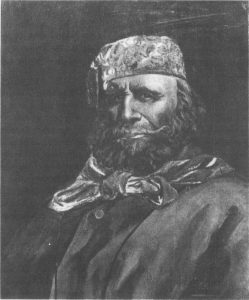 Francisco Felix de Sousa.
Francisco Felix de Sousa.
1810, As British crack down on slave trade, local merchants become more prominent. Soon famous on the Slave Coast is Francisco Felix de Sousa, born in Bahia of Portuguese descent. Working with demanding Brazilian slavers, he moves into old Portuguese factory in Whydah and soon dominates slave-trading.
He helps King Ghezo gain the throne of Dahomey in 1818 and in return is named “Chacha” to oversee slave trade along entire coast. His customers gain access to thousands of captives annually, supplied by the constantly warring Ghezo.
De Sousa has several wives, including local princesses, many mistresses and more than 80 children before his death in 1849.
His descendants play central roles in large, ongoing Afro-Brazilian communities, in the drive for independence and, to this day, in Benin politics.
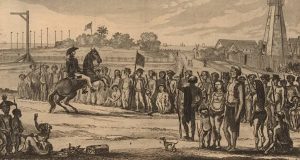 Rebels turned back.
Rebels turned back.
1811, Insurrection sees as many as 125 slaves set out from German Coast sugar plantations on the Mississippi (including several owned by James Brown, sent to U.S. Senate the following year) to march on New Orleans. Several rebel leaders are said to have been brought from Saint-Domingue by refugee white owners; but this is not confirmed. Two white men die (no more) and five plantation manors burn, as well as sugar mills and crops.
Confronted by militia, 45 blacks are killed, more are hunted down and shot, and another 44 are tried, and hanged or shot by firing squad, with heads displayed on pikes. Possibly largest slave revolt in U.S. history, Jan. 8-10.
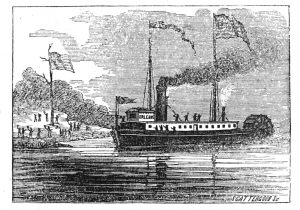
The New Orleans.
1811, New Orleans, the first Mississippi steamboat, is launched at Pittsburgh, March. Robert Fulton and Robert Livingston are the designers, and Nicholas Roosevelt the builder, with most machinery hauled overland from New Jersey. Steam power is critical to overcoming current on upriver legs.
By the 1830s more than 1,200 riverboats are navigating the western rivers and carrying increasing volumes of cotton down to the port of New Orleans.
Many slaves are brought from the Upper South to New Orleans via the Gulf by ship, sold there and taken upriver to plantations. Perhaps as many as 4,500 blacks will work on the riverboats themselves, 1,500 of them free men.
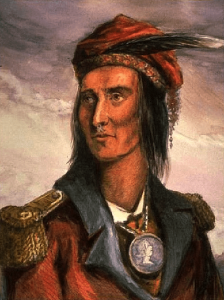 Tecumseh.
Tecumseh.
1811, In Battle of Tippecanoe, Shawnee and other Indians led by Tecumseh’s brother, Tenskwatawa (The Prophet), are fought off by soldiers under William Henry Harrison, governor of Indiana Territory, Nov. 7. Fewer than 70 killed on either side, but Indians retreat and troops burn their food stores and village, Prophetstown (near present-day Lafayette, IN).
British support for Tecumseh and his confederation of warriors is cited in U.S. declaration of war on Britain on June 18, 1812. It’s the nation’s first such declaration, voted by Congress and signed by Pres. James Madison.
1811-1812, New Madrid Earthquakes (estimated M ranging from 7.0 to 8.6) and aftershocks shake up Mississippi Valley from New Madrid, MO, to Memphis, Dec. 16, Jan. 23 and Feb. 7.
Warriors in Tecumseh’s confederation attribute quakes to powers of his brother, The Prophet.
1811, Valongo Wharf opens in Rio de Janeiro. Over the next 20 years, it is the entry point for perhaps 900,000 enslaved Africans, most of them from Angola, Kongo and Mozambique. Also here are slave-auction blocks, a quarantine station, and the Cemetery of Pretos Novos, where many thousands who die of disease are buried.
1812, U.S. forces surrender Detroit to Tecumseh and British Gen. Isaac Broick, Aug. 16, and fail in attempted invasion of Ontario at Queenston Heights, Oct. 13, near the Niagara border. British aided there by Mohawk chiefs.
1812, Louisiana joins Union as the 18th state, slavery permitted to continue.
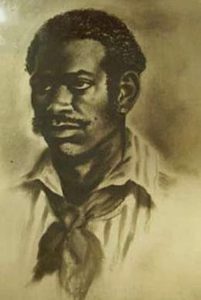 Jose Antonio Aponte.
Jose Antonio Aponte.
1812, Slave revolts, led by José Antonio Aponte (a free black militia corporal of Yoruba descent), erupt on plantations near Havana. Militia suppresses rebels, arresting hundreds of enslaved people; Aponte and other leaders are executed.
Background: From 1790 to 1805, Cuba welcomed many refugee whites from Saint-Domingue (with their expertise in sugar refining and their slaves) but is less generous toward free refugees of color.
More land is dedicated to sugar cane, tens of thousands more slaves are brought in from Africa, and Cuba is soon outproducing declining Haiti. Even after Spain signs treaty with Britain banning slave trade as of 1820, Cuba slave population continues to expand, from 39,000 in the 1770s to 600,000 in the 1840s.
1812, New York State establishes permanent system of public schools organized by district with some support from taxes and state land sales, but most from parent-paid fees.
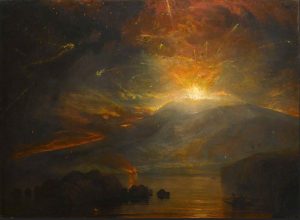
Explosive fireworks.
1812, La Soufrière erupts on St. Vincent, killing 34 slaves on several north-end plantations, April 27-29.
1812, Napoléon invades Russia with 600,000-man Grand Armée, June 24, fights Battle of Borodino and enters Moscow, Sept. 14. Capital set ablaze by Russians that night. Only 10,000 of his army get back to their Neman river starting point, December, and many of these die before spring.
Fifteen months and several defeats later, Napoléon is exiled to Elba.
 East of Detroit.
East of Detroit.
1813, Battle of the Thames sees Harrison’s U.S. forces defeat Tecumseh’s Indian confederacy in Ontario, 75 miles east of Detroit, Oct. 5. Tecumseh and his war leader, Roundhead, are killed.
1813, British Gov. Charles William Maxwell of Sierra Leone sends force to shut down slave factory at Cape Mesurado (future site of Monrovia in Liberia). Ships seized, slaves freed and British factory owners Robert Bostock and John McQueen sentenced to 14 years in New South Wales by admiralty court in Freetown.
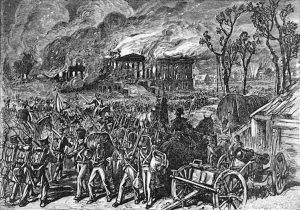
Executive Mansion afire.
1814, British Adm. Alexander Cochrane offers freedom to slaves escaping U.S. masters, April. More than 4,000 gain Cochrane’s Tangier Island base in Chesapeake Bay, in largest U.S. slave emancipation before Civil War.
Ex-slave Colonial Marines help burn Washington, including Capitol and Executive Mansion, Aug. 24-25. They also take part in attack on Fort McHenry, September. At war’s end, 2,600 of these ex-slaves resettle in Nova Scotia; 700 others go to Bermuda, and later to Trinidad.
1814, After many sharp skirmishes, Creek War between Red Stick Creek (allied with British) and Lower Creek (allied with U.S.) ends with Gen. Andrew Jackson leading victory over Red Sticks at Horseshoe Bend on Alabama’s Tallapoosa river, March. Allied Creek still forced to cede 22 million acres in Georgia and Alabama (Treaty of Fort Jackson). Red Stick leaders flee into Florida.
1815, New England Federalists who oppose “Mr. Madison’s War” meet in Hartford, CT, and call for amendments to U.S. Constitution to remove three-fifths count of slaves and to require two-thirds majority of Congress for declarations of war and admission of new states, Jan. 5.
Instead, the anti-war tone discredits Federalists, leading to their demise as a political force.
1815, Battle of New Orleans, Jan. 8, 18 days after Treaty of Ghent is signed, which returns the two nations to status quo before war.
Gen. Andrew Jackson leads outnumbered U.S. forces (including 462 free black volunteers) to lopsided victory over British Gen. Pakenham and Adm. Cochrane.
1815, Battle of Waterloo ends Napoléon’s comeback bid, June 18.
1815, Large U.S. squadron under Stephen Decatur threatens bombardment of Algiers, which, with other Barbary states, returned to seizure of U.S. ships and sailors during War of 1812. Dey of Algiers agrees to release 10 captive Americans, pay $10,000 and end all tribute demands, June 30.
In 1816, a British-Dutch fleet bombards Algiers, Aug. 27, to enforce a new treaty, win freedom for 1,083 enslaved Christians and end, finally, Barbary piracy. In 1830, Algiers is seized and colonized by France.
1815, At Congress of Vienna, British pressure Spain, Portugal, France and the Netherlands to abolish slave trade, although Spain and Portugal, British allies in the war, are permitted several years of continued slaving south of equator to replenish labor supplies.
Agreement broadens mandate of Royal Navy anti-slavery patrols. But new Mixed Commission Courts are rarely tough on slavers and “equipment clause” is not applied until 1830s. U.S. continues to refuse British anti-slaver patrols permission to board U.S.-flagged ships.
1815, Spanish crown grants Puerto Rican planters right to import slaves from non-Hispanic Caribbean islands (but not directly from Africa) despite anti-slaver promises to Britain. This rewards Puerto Rican Creoles for their loyalty during colonial revolutions in Mexico and South America.
Between 1790 and 1815, island’s slave population more than doubles to 20,000.
But slaves here have right to buy their freedom, and the free African population is consistently estimated to be greater than the enslaved.
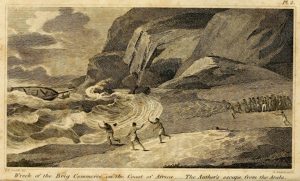 The Brig Commerce struggles to stay afloat on turbulent Moroccan coast.
The Brig Commerce struggles to stay afloat on turbulent Moroccan coast.
1815, Capt. James Riley and the crew of Commerce, an American brig, are shipwrecked on Moroccan coast, August. They are taken captive by Saharawi hunters who reduce them to slaves, beat and starve them. They endure a harrowing desert march of hundreds of miles to Mogador. The British consul there, William Willshire, pays their ransom from a special fund.
Back in Connecticut, Riley writes a book very much from the enslaved’s point of view, and works for the abolition of black slavery.
Years later, Abraham Lincoln says Riley’s 1817 book, best-known as Sufferings in Africa, is one of three works that most shaped his political views, especially on slavery. The others are the Bible and Pilgrim’s Progress.
1815, HMS Comus captures seven Spanish and Portuguese slave ships at Duke Town (Calabar, present-day Nigeria), March. Most of the 550 slaves freed are Igbo.
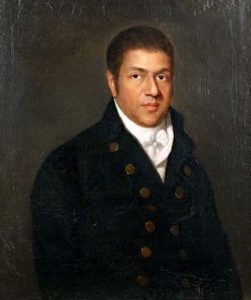 Paul Cuffe.
Paul Cuffe.
1816, Paul Cuffe, free, mixed-race shipbuilder from Westport, MA, arrives at Freetown, Sierra Leone, with 38 free American blacks (20 of them children) and considerable supplies, in hopes of supporting British colony’s black population with trade.
He works closely with fellow-Quaker abolitionists in U.S. and England, as interest in black emigration to Africa expands in U.S.
1816, Indiana becomes the 19th state, free under the Northwest Ordinance. The Shawnee, Delaware, Wyandot and four other tribes agree to leave traditional homelands for small reservations in Ohio and Indiana, in 1817 Treaty of Fort Meigs. Most will be moved again, to the Indian Territory, in 1830s.
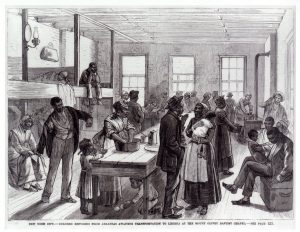 Black refugees await transportation to Liberia from Mount Olivet Chapel.
Black refugees await transportation to Liberia from Mount Olivet Chapel.
1816, American Colonization Society founded by Robert Finley, Presbyterian minister from New Jersey, supported by both Quakers and prominent Virginia slave masters (who worry that free blacks are instigating slave escapes), in Washington, Dec. 21. Dedicated to manumission of slaves and settlement of freed blacks in West Africa.
Society does not believe expanding population of freed blacks can be integrated into U.S. society. Liberia ultimately created adjoining Sierra Leone, with Cape Mesaduro to be the eventual site of Monrovia. But ACS effort comes to be opposed by most U.S. blacks and eventually by most abolitionists.
Free people of color in U.S.: Rises from 60,000 in 1790 to 300,000 by 1830.
1816, More than 700 former U.S. slaves who fought in British Adm. Cochrane’s Corps of Colonial Marines during War of 1812 accept Britain’s offer of transfer from Bermuda and settlement in Trinidad where, as “the Merikens,” they successfully establish towns initially headed by their old sergeants.
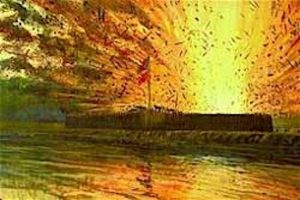 Save haven for Negros goes up in flames.
Save haven for Negros goes up in flames.
1816, Some 200 escaped slaves, led by three former Colonial Marines who had fought with British, plus 30 or more Seminole and Choctaw defend the British-built “Negro Fort” on northern Florida’s Apalachicola river against larger U.S. army force, July 27.
Hot shot from a U.S. gunboat fires the fort’s magazine. Explosion kills or wounds most of those inside, including women and children. Survivors are enslaved. Georgia urged Gen. Jackson to send U.S. force and Creek allies into Florida, Spanish again, to pursue and punish Seminoles and runaway blacks. Action paves way for final withdrawal of Spain from Florida and Seminole Wars.
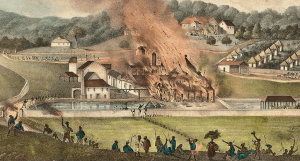 Slave's army attacks Barbados plantation.
Slave's army attacks Barbados plantation.
1816, A slave, Bussa, leads three-day uprising of many thousands on Barbados. Seventy plantations overrun, fields and mills burn, April 14-15. Rebels are otherwise restrained; only two whites are killed. But more than 120 slaves die in fighting against mounted militia, including Bussa. Later, another 144 executed.
This is first of three significant slave rebellions in British West Indies that abolitionists cite in Parliament with effect. The others, in which rebels also forbear from widespread killing, are in Demerara (Guyana), 1823, and on Jamaica, 1831 (see below).
1816, Year Without a Summer. The 1815 eruption of Mount Tambora (Indonesia), world’s greatest in at least 1,300 years, leads to mass amounts of atmospheric dust interrupting sunlight and the coldest temperatures recorded in Europe between 1766 and today. Food shortages in Europe and Asia result in famine, disease, protest marches, riots.
North America experiences crop failures in colder regions, freezing temperatures into the summer and high food prices. Many hard-pressed New Englanders migrate into western New York, including Joseph Smith, who will become the Mormon prophet.
1817, Mississippi joins Union as the 20th state; slavery permitted.
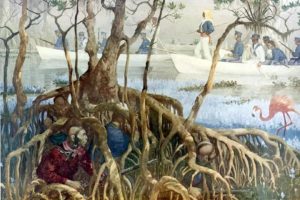 Escaped slaves hide from Gen. Jackson's army.
Escaped slaves hide from Gen. Jackson's army.
1817-1818, First Seminole War, with U.S. Gen. Jackson pursuing escaped slaves harbored by Seminoles in Florida. Georgia accuses Seminoles of raiding plantations. Indian villages are burned. Jackson also seizes Spanish-held Pensacola.
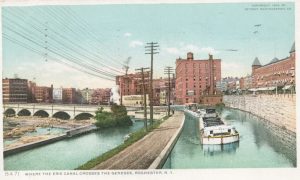 A ship sails on the newly formed Erie Canal.
A ship sails on the newly formed Erie Canal.
1817, New York State begins work on Erie Canal, July 4, to connect Lake Erie, at Buffalo, to Hudson River, at Albany. It runs 363 miles long, 40 feet wide and 4 feet deep when opened in 1825.
 Jesse Torrey listens to stories from slaves.
Jesse Torrey listens to stories from slaves.
1817, Jesse Torrey, white Philadelphia physician, publishes A Portrait of Domestic Slavery, in the United States. He focuses new attention on frequent gangs who kidnap free black families.
1817, Britain and Spain sign treaty prohibiting slave trade, Sept. 23. Spain agrees to end trade north of equator immediately, with trade to south ending in 1820. British naval vessels empowered to search suspected Spanish slave ships. But loopholes continue, especially to sugar-rich Cuba, which receives estimated 124,000 African slaves between 1821 and 1853.
1817, Le Louis case establishes that British naval vessels cannot search foreign vessels suspected of slaving unless permitted to do so by their respective countries, hampering British efforts to suppress trade. Slave ship was seized by HMS Queen Charlotte of the West Africa Squadron, expanded to six ships and now based at Freetown, where Le Louis admiralty trial takes place.
1818, Illinois joins the Union as the 21st state, free under the Northwest Ordinance.
1818, Cuba continues to expand sugar plantations and slave population, as Spain finally allows it to trade freely with the U.S. and other major sugar markets. Production, at 14,000 tons in 1790, rises to 55,000 tons by 1820.
1818, Chile (under O’Higgins) and Argentina (led by San Martin) win independence with victory at Battle of Maipú, near Santiago.
1818, Spain forbids slave trade to Mexico.
1819, Alabama joins Union as the 22nd state, slavery permitted.
1819, U.S. Congress passes legislation stiffening provisions against American participation in the slave trade. Navy sends out more ships to patrol U.S. coast and mid-ocean.
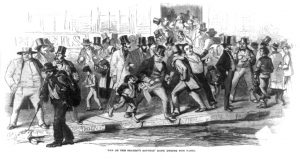
Frantic mob raids bank during financial panic.
1819, Financial panic in U.S. Widespread foreclosures, collapsing banks and a sharp increase in poverty in first major U.S. depression. Economic pain is widespread for more than two years. Southern plantations suffer further from competition as cheap, India-produced cotton surges.
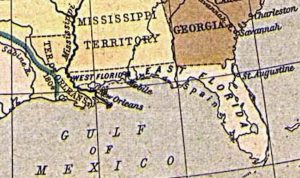 1819, Spain, exhausted from war with Napoleon and under great pressure from Latin America independence movements, agrees to cede Florida to the U.S. (which has already taken Mobile and Pensacola in the First Seminole War). The Adams-Onís Treaty, signed Feb. 22, requires U.S. to pay resident claims against Spain up to $5 million, and to drop claims to parts of Spanish Texas.
1819, Spain, exhausted from war with Napoleon and under great pressure from Latin America independence movements, agrees to cede Florida to the U.S. (which has already taken Mobile and Pensacola in the First Seminole War). The Adams-Onís Treaty, signed Feb. 22, requires U.S. to pay resident claims against Spain up to $5 million, and to drop claims to parts of Spanish Texas.
A group of Seminole, most of them free blacks now vulnerable to enslavement, flee Cape Florida in 1821 and establish Red Bays community on north end of Bahamas’ Andros island. By 1837, more than 150 sail the 160-mile escape route.
1819, Portugal bans slave trading north of the equator, but protects trade to Brazil. Britain further expands naval squadron off the West African coast to patrol the area against slavers.
1819, Le Rôdeur (The Prowler) of Le Havre, boards 160 captives at Bonny, April, and sets course for Guadeloupe. A blinding eye affliction breaks out among the slaves, 36 of whom are sent overboard in a vain attempt to stop the spread.
As the ship nears Guadeloupe, only one of the crew retains sight. They encounter a Spanish slaver, Leon. She can offer no help for her crew and slaves are all blind, and the ship lurches along unguided. Le Rodeur makes it to Guadeloupe, June 21, her single sighted sailor contracting blindeness three days later. Leon is never again heard from.
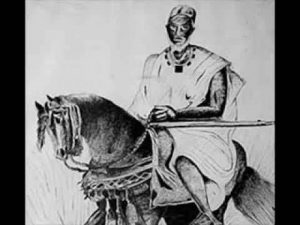 Seku Amadu.
Seku Amadu.
1819, Djenné falls to a jihad led by Seku Amadu, a Fulani, who establishes the Massina Empire in the Niger’s inland delta region. He is inspired by Sufism and by the Sokoto Caliphate to the east and is supported by Muslim slaves of previous traditionalist Bambara rulers. Amadu abandons 500-year-old Grand Mosque in favor of less ostentatious structures and establishes a new capital, at Hamdullahi, as well as 600 madrassas.
Alcohol, tobacco, music, dancing forbidden under strict Islamic law. Leading a 10,000-man army, Seku Amadu takes Timbuctu in 1825 and is welcomed by scholars there. Massina Empire dominates the delta and the Niger Bend under Amadu’s son and grandson through 1860.
